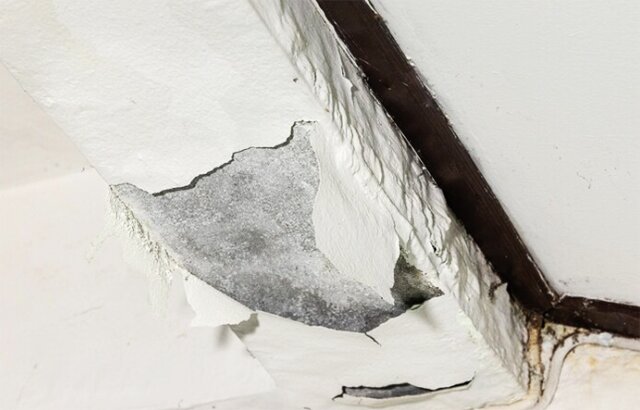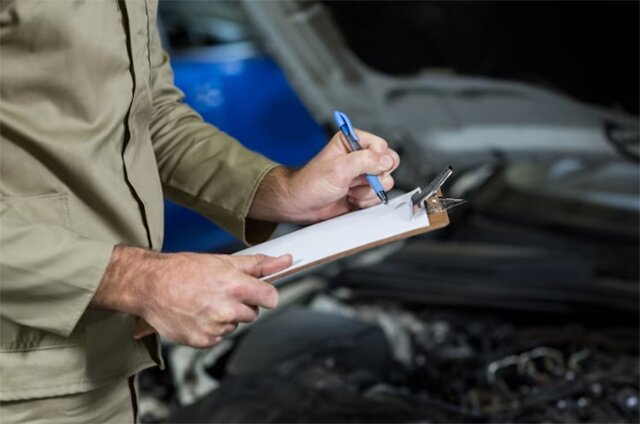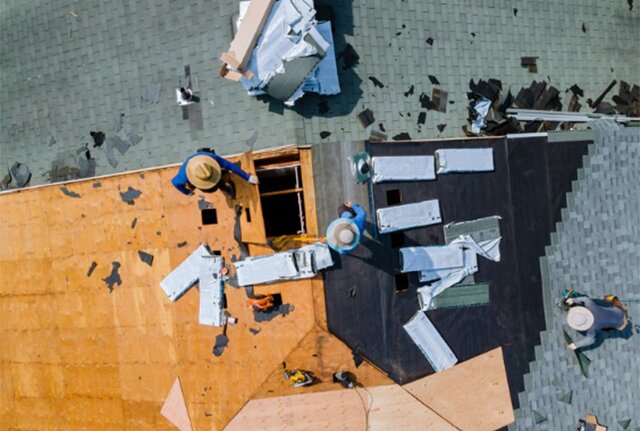Do you have a leaky roof? Don’t panic! Even the most experienced homeowner can experience roof issues every now and then. And while it’s important to get your roof fixed as soon as possible, it’s also important to understand what caused the damage in the first place so that you can take steps to protect your home from future damage. In this article, we’ll provide you with the essential information needed to understand how to repair your roof and safeguard your home from further damage.
Disclaimer: This article provides general information about the repair and protection of roofs, but it is not intended as a substitute for professional advice. If you have any questions or concerns about your roof, we recommend that you contact Advance Roofing LLC at advanceroofingllc.com – we are always ready to help! For those in the Spokane, WA area, Advance Roofing LLC has been providing the highest quality roofing solutions for many years.
Problem of Leaky Roofs
Leaky roofs can be one of the most frustrating problems a homeowner can face. Not only can they potentially cause significant damage to your home’s structure, but they can also be difficult to detect and fix. The longer you ignore the issue, the more it can cost you in both time and money.
It’s important to address leaky roofs as soon as possible to prevent further damage to your home. Not only can water damage cause structural issues, but it can also lead to the growth of mold and mildew. In severe cases, leaky roofs can even lead to basement wall damage and other serious issues.
The first step to repairing your leaky roof is identifying the causes.
Causes of Roof Leaks

Roof leaks can be a homeowner’s nightmare, causing damage to your property and leading to expensive repairs. Understanding the causes of roof leaks can help you address the issue quickly and prevent further damage to your home.
- One of the most common causes of roof leaks is damaged or missing shingles. Over time, shingles can become worn and cracked due to exposure to harsh weather conditions. This damage can allow water to penetrate your roof’s surface and seep into your home.
- Clogged gutters can also cause roof leaks. Gutters are designed to direct water away from your roof, but when they become clogged with debris such as leaves and twigs, they can’t do their job effectively. This can cause water to back up and potentially seep into your home.
- Faulty flashing is another common cause of roof leaks. Flashing is a crucial component in protecting your roof from water damage. If it is damaged or installed incorrectly, it can compromise the roof’s integrity and lead to leaks.
- Age-related wear and tear is also a common cause of roof leaks. As your roof ages, it can become more vulnerable to damage from weather conditions like rain and wind. Additionally, the seals and joints on your roof can degrade over time, leading to leaks.
- In some cases, roof leaks may also be caused by poor workmanship or improper installation. If your roof was not installed correctly, it may be more prone to leaks and other issues.
Regular roof inspections can help identify potential issues before they become major problems, and addressing any leaks promptly can prevent costly repairs down the road. By understanding the common causes of roof leaks, you can take steps to protect your property and keep your home safe and dry.
Inspection and Repair

Regular inspection and maintenance of your roof is crucial in protecting your home from water damage and other related issues. The following tips can help you keep your roof in tip-top shape and avoid costly repairs or replacements.
- First and foremost, it’s essential to inspect your roof regularly, especially after severe weather conditions such as storms or strong winds. Look for signs of damage, including missing shingles, cracked or curling shingles, and loose or damaged flashing. Additionally, check for water stains and damp spots on your ceiling, which could be a sign of a leak.
- To prevent future issues, it’s also essential to keep your gutters clear of debris and clogs. Regularly cleaning your gutters can help ensure that they function properly, directing water away from your roof and preventing potential damage from water backup.
- If you have a flat roof, it’s also crucial to inspect and maintain the roof surface regularly. Look for signs of damage, including blistering, cracking, and splitting. Flat roofs may require specialized sealants and coatings.
- Finally, it’s essential to keep up with regular maintenance to prevent potential issues and prolong the life of your roof. This includes tasks such as trimming tree branches that hang over your roof, which can damage shingles and other roofing materials.
If you notice any signs of damage or leaks, it’s crucial to have them repaired immediately to prevent further damage to your roof and home.
Determining the Origin of a Roof Leak
If you notice a water stain on your ceiling or a damp spot in your attic, it’s crucial to identify the source of the leak before it causes extensive damage to your roof and home. Here are some steps to help you identify where the leak is coming from:
- Check your roof for obvious signs of damage. Look for missing or damaged shingles, cracked or deteriorated flashing, and damaged or clogged roof vents. These areas are common sources of leaks.
- Check your attic for signs of water entry. Look for damp insulation, water stains, and mold growth. Follow the trail of water to the highest point of entry, which will lead you to the area where the leak originates.
- Check your gutters and downspouts. If they’re clogged or damaged, they can cause water to back up under your roof shingles, leading to leaks.
- Check your chimney and skylights. These areas are also common sources of roof leaks, so make sure they’re properly sealed and free from damage.
- Use a hose to simulate rain. Once you’ve identified the most likely areas of entry, use a hose to simulate rain and see if you can replicate the leak. Start at the bottom of the roof and work your way up until you locate the leak.
Once you’ve identified the source of the leak, it’s important to have it repaired as soon as possible.
Inspecting for Signs of Damage

It’s critical to inspect your roof for signs of damage that may impact its overall function and lifespan.
Potential issue to be aware of is damage from severe weather. High winds, hail, and heavy rainfall can cause significant damage to your roof, such as missing shingles, cracks, and dents. Even if you don’t see any visible signs of damage, it’s a good idea to have your roof inspected after a storm to ensure that everything is still intact and functioning properly.
In addition to this warning sign, it is important to inspect the more inconspicuous areas of your roof that may be susceptible to damage. For example, check the roof vents and joints for signs of wear and tear, as these areas may be more susceptible to leaks. Also, inspect the roofing paper and sealant for any cracks or gaps that may allow water to seep in.
By keeping an eye out for warning signs, you can catch problems early on and take the necessary steps to address them before they.
Locating Potential Damage Areas
Water intrusion is one of the most common issues on a damaged roof. If you have water stains on your walls or ceiling, this could be a sign that your roof is leaking. You should check your attic for signs of moisture and mold growth, as this could indicate that your roof is leaking.
- Take a close look at your shingles for signs of damage or wear and tear. If you notice any missing or broken shingles, this could leave your roof vulnerable to water damage.
- Cracked or curling shingles can also be a warning sign that your roof needs attention.
- In addition, check out the color of your shingles. If you notice that they are darker in some spots, this could indicate that they are absorbing moisture, which could lead to mold and mildew growth.
Another place to inspect for potential damage is around roof penetrations such as chimneys, vents, and skylights. These areas are especially vulnerable to leaks and damage due to wear and tear over time. Check for any cracks, rust, or missing components around these areas. In addition, examine the flashing around these penetrations, as this is another common source of water infiltration.
Clogged gutters can lead to serious damage on your roof and throughout your home. If your gutters are clogged with leaves, dirt, or debris, this can lead to water accumulation on your roof and the potential for rot and mold growth. Clean your gutters regularly and make sure they are properly secured and in good working condition.
By being proactive and regularly inspecting your roof, you can catch potential damage areas early on and prevent costly repairs down the line. If you notice any signs of damage or wear and tear on your roof, it’s important to address these issues promptly.
Professional Repairs Versus DIY Solutions

When it comes to repairing your roof, you may be wondering whether to tackle the job yourself or hire a professional roofing contractor. While DIY solutions may seem cost effective and empowering, the truth is that they can end up costing you more in the long run if you don’t have the necessary skills and expertise.
Here are some key reasons why professional repairs may be the better choice:
- Safety First: Roof repair work can be dangerous and requires proper safety gear and precautions. Professional roofing contractors are well versed in the safety requirements of the job, including how to work on a pitched roof and use harnesses and ladders safely. If you’re not experienced with roof repair work, trying to DIY a solution could put you in harm’s way.
- Quality Assurance: Professional roofing contractors have the skills and knowledge to diagnose the root cause of your roofing issue and provide a reliable repair solution. By contrast, DIY repairs may only address the visible symptoms, leaving underlying issues to fester and create further damage.
- Cost-Effective: Hiring a professional roofing contractor can actually save you money in the long run. Professional contractors have access to materials and products at better prices than those available to DIY enthusiasts. Additionally, professional repairs are often covered by a warranty, providing peace of mind in knowing that you are protected from any workmanship errors or further damage.
- Time-Saving: Roof repair work can be time-consuming, especially if you’re doing it yourself without prior experience. By hiring a professional roofing contractor to do the job, you will free up time to focus on other important tasks, without the added stress or worry of doing the job incorrectly.
- Enhanced Curb Appeal: Professional roofing contractors not only repair your roof issues, but they also leave the roof looking more aesthetically pleasing. Properly repaired roof not only adds value to your property, but also enhances the overall look of your home.
Thanks to the experience of professional roofing contractors, their protective equipment, a cost-effective solution and in order to save time, roof repairs will be carried out in the shortest possible time and with maximum protection of your home.
Replacement and Maintenance
The roof of your home is one of the most important parts of its structure, protecting you and your family from the harsh elements of the natural world. However, like most things in life, roofs do not last forever. Eventually, they will need replacement or maintenance.
Regular maintenance of your roof can greatly extend its lifespan and save you money in the long run. Simple tasks like cleaning out gutters, removing debris, and trimming overhanging branches can go a long way in preventing damage to your roof. Regular inspections should also be conducted to check for any signs of wear and tear.
When it comes to roof replacements, it’s important to choose the right materials for your home and the environment you live in. Not all roofs are created equal, and some materials perform better in certain climates or environments. For example, asphalt shingles are a popular choice in areas with moderate climate conditions, while metal roofs are more commonly used in areas that experience a lot of rain or snow.
It’s important to take good care of your roof to protect your home and family. Regular maintenance and inspections by professional roofing contractors can go a long way in preventing damage to your roof and extending its lifespan. If a replacement is necessary, make sure to choose the right materials for your home and environment for optimal performance and protection.
Flat Roofs Versus Shingle Roofs
When it comes to selecting the right roofing material for your home, there are a variety of choices to consider. Two popular options are shingle roofs and flat roofs. While both options have their own advantages and disadvantages, it’s important to choose the right one for your specific needs.
Shingle roofs are a traditional option that many homeowners prefer for their aesthetic appeal and durability. They come in a variety of colors and are versatile enough to match the design of any home. Shingles are also highly resistant to weather conditions and can last up to 15-20 years before needing replacement.
On the other hand, flat roofs have gained popularity in recent years due to their simple and modern look. They are also often more cost-effective to install than shingle roofs, making them an attractive choice for budget-conscious homeowners. Flat roofs are also easier to maintain and provide more space for installing solar panels or rooftop gardens.
However, flat roofs do come with their own set of drawbacks. They are more susceptible to leaks and water damage, which can be a major issue if not properly maintained. Flat roofs also require frequent maintenance to ensure that water is properly drained off the surface. This is because the water can pool on the surface and cause extensive damage to the roof.
Shingle roofs have their own disadvantages as well. They are more vulnerable to wind damage and may need to be replaced more frequently in areas that experience heavy snow or rain. Additionally, shingles are not as eco-friendly as flat roofs since they are often made from petroleum-based products.
Ultimately, the decision between a flat roof and a shingle roof comes down to personal preference, budget, and the environment in which you live. It’s important to choose a roofing material that can withstand the weather conditions in your area and that will suit the design of your home.
Professional Installation and Maintenance Services

Professional installation and maintenance services are key to ensuring the longevity and reliability of your home’s roof. While DIY repair and maintenance may seem like a tempting option, it’s essential to rely on the expertise of roofing professionals to avoid costly mistakes and ensure your roof is in top condition for years to come.
When it comes to installation, a professional roofing contractor can help you select the best roofing material and style for your home’s needs and aesthetics. Their experience and knowledge allow them to identify potential issues before they become major problems and ensure that the installation is done correctly.
Regular maintenance is also essential to extend the lifespan of your roof and prevent costly repairs. Professionals can inspect your roof for signs of damage, ensure that the gutters and vents are clear of debris, and address any concerns and repairs in a timely manner.
If you do encounter an issue with your roof, such as a leak or damage from severe weather conditions, calling a professional for repairs is crucial. They have the tools and expertise necessary to accurately diagnose and quickly fix the issue, preventing further damage to your home.
Another benefit of working with professionals is that they can guide you through the insurance claims process. Roof damage can be covered by insurance, and a professional roofing contractor can help you navigate the paperwork and process to ensure a smooth and successful claim.
Investing in professional installation and maintenance services for your home’s roof can save you time, money, and stress in the long run. Your roof is a crucial part of your home’s protection, and trusting the professionals ensures that it’s in the best possible condition.
Re-Roofing and Replacing Damaged Decking or Vents
Over time, even the best-maintained roofs will inevitably need repairs or replacements. Two common areas that may need attention are the roofing decking and vents. If you’re facing issues with these parts of your roof, it’s important to understand your options.
Firstly, let’s discuss roofing decking. This is the part of your roof that provides the structural support for your shingles or tiles. Damage to the roof decking can occur due to extreme weather conditions, pests, or simply old age. If left unchecked, it can lead to further damage in the rest of your roof and even compromise the safety of your home.
Another important part of your roof that may require attention is the vents. These are the small structures on the roof that regulate attic ventilation. Damage to roof vents can occur due to harsh weather conditions or animal interference. A damaged vent can reduce ventilation, leading to increased moisture and the potential for mold growth, as well as affecting the energy efficiency of your home.
If your roof needs repairs or replacements, it’s essential to work with a knowledgeable and experienced roofing contractor. They can assess your needs and provide expert advice on the best options for your home. With proper care and attention to the roofing decking and vents, your home can enjoy a safe and healthy roof for years to come.
Regularly Scheduled Maintenance Checks

Regularly scheduled maintenance checks are crucial for ensuring the longevity of your roof and protecting your home from potential damage. Many homeowners tend to overlook the importance of proactive maintenance, but it can save you a lot of money and headaches in the long-run.
One of the most important aspects of routine maintenance checks is inspecting for signs of damage. This includes checking for leaks, water stains, and any visible cracks or holes. By catching these issues early on, you can avoid more costly repairs down the line.
Roofing experts recommend scheduling maintenance checks at least once a year. However, if you live in an area with severe weather conditions or have many trees surrounding your home, it may be beneficial to schedule maintenance checks more frequently.
Most roofing contractors offer maintenance programs that include regular inspections and maintenance, providing homeowners with peace of mind and ensuring their roofs are in top condition. Be sure to find an experienced and reputable contractor in your local area to ensure your maintenance checks are thorough and effective.
Preventative Measures
Prevention is always better than a cure, and this certainly holds true when it comes to keeping your roof in good condition. Taking preventative measures can save you time, money, and the frustration of dealing with extensive damage caused by neglect.
- One of the most important things you can do is to have regular maintenance checks conducted by a qualified roofing professional. These checks should include a thorough inspection of your roof, gutters, and downspouts to identify any potential issues that could cause damage. Even small problems, if left unchecked, can quickly escalate and result in more costly repairs.
- In addition to regular inspections, it’s also important to keep your roof clean. The accumulation of debris like leaves, branches, and twigs on your roof and in your gutters can block proper drainage, resulting in water backup and potential roof damage. It’s important to regularly remove any debris to prevent these issues.
- Another preventative measure is to ensure that your roof has proper ventilation. Adequate ventilation helps to regulate the temperature of your roof and prevent the buildup of moisture, which can lead to mold and mildew growth. This is especially important in areas with high humidity or frequent rain. A qualified roofing professional can help you assess whether your roof has sufficient ventilation and make recommendations for improvement if necessary.
Regular cleaning and maintenance can also help prevent damage caused by harsh weather conditions. For example, regularly removing snow and ice buildup from your roof can help prevent damage to your shingles or other roofing materials. Similarly, removing debris from your gutters can prevent damage caused by heavy rain and wind.
Conclusion
In conclusion, taking the necessary steps to repair and protect your roof is essential for maintaining the integrity of your home. From regular inspections and maintenance to proper ventilation and cleaning, there are many ways to prevent and address issues that can lead to roof damage and leaks. It’s important to stay vigilant and proactive in addressing any potential issues, and to seek the help of a qualified roofing professional as needed. By investing in the health of your roof, you can help ensure the safety and stability of your home for years to come. Additionally, remember to consult with your insurance company or the national flood insurance program if your home has suffered damage from a leaky roof or severe weather, as they may be able to provide assistance in covering the cost of repair.



 509-201-4190
509-201-4190
